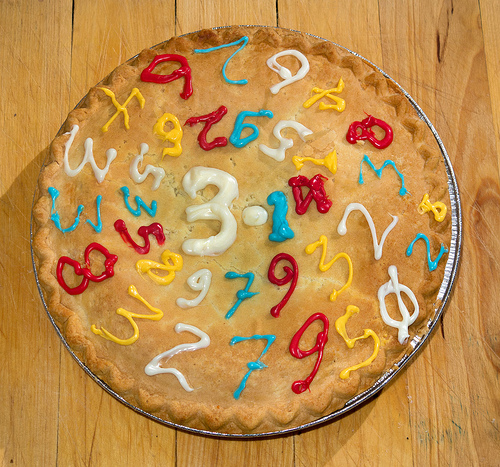

Yesterday was Pi Day – March 14 or 3.14 – and I heard a little story about this on NPR as I was driving into work. It reminded me how much my journalism students hate math.
Many, if not most, journalism students tend to get into the field because they like writing. When I hand them assignments asking them to calculate a percentage change, I am often met with lamentations of, “I went into journalism so I wouldn’t have to do math!”
Well, I tell them, then you might want to readjust your expectations quickly. Journalism is full of math. For example, it’s election season right now; do you know the difference between a majority and a plurality? And how about all those polls we hear so much about? Yep, math.
The stakes are even higher now in the age of “data journalism.” (In truth, data has always been in journalism; it’s just we can do so much more with it now and visualize it in so many interesting ways.)
Introducing my multimedia journalism students to web analytics or even basic spreadsheet functions can be a tough sell sometimes. It’s nerdy. It’s not sexy like shooting with DSLRs and making videos. It’s not as fun as social media. But, I tell them, employers are increasingly expecting new hires to have some core math and data skills.
Journalism is fact-finding and fact-reporting. Numbers, to the extent that they are gathered through valid and reliable methods, give us specifics. (Of course, a Mark Twain quote about lies, darn lies and statistics comes to mind here.)
When we can get ahold of good numbers, we can cut through the squishy semantics of what people tell us in interviews. We can present our audiences with something more than our observations reported through our personal lenses of perception. This, I tell my students, should be a source of great peace and comfort for them as journalists.
Numbers, or the lack thereof, can also tell us what we don’t know, what we’re missing. For example, take this article from “The Week,” republished on the Poynter Institute’s website back in 2013. It points out that we don’t have good data on the number of Christians working in newsrooms, and that information might provide useful insight into how news organizations cover topics with specific relevance to the Christian faith.
I’ve always found journalism to be a beautiful opportunity to pursue truth from all angles. Yes, a good column from someone with fire-in-the-belly passion is a wonderful way to understand how others perceive and react to the world around us.
Absolutely, we need to speak to credible sources for eyewitness accounts of newsworthy events, and we need people in the field reporting on their own observations.
But the universe is built on math. Whether journalists are reporting on the discovery of gravitational waves, increased property taxes, LeBron James’ 3-point-field-goal percentage, box office sales for the latest hit movie, art auction sales or the latest corporate merger – chances are they’re going to run into math somewhere.
Thinking we can avoid math in journalism is just irrational.
Jeff Neely is an assistant professor of journalism at The University of Tampa, where he teaches courses in newswriting, feature writing, multimedia journalism and literary journalism. His research has examined the role narrative and literary journalism can play in broadening our understanding of various issues and experiences life brings our way, from identity formation to environmental ethics. He has also studied how youth journalism programs, where young people tell their own stories and those of their peers, can help strengthen local communities. He is currently working with local non-profit outreach organizations to build a youth journalism program called Tampa Youth Voice. Prior to entering academe, Jeff worked as a writer and editor for various publications in and around the Tampa Bay area, as well as a case manager and resource development specialist for the Florida foster care system.

As a non-journalist consumer, I’ve been struck by how much the lines are blurred between journalism and data science. For example, this New York Times piece on gun sales appears to contain a fair bit of original data analysis.
http://www.nytimes.com/interactive/2015/12/10/us/gun-sales-terrorism-obama-restrictions.html?_r=0
That’s perhaps an ambitious outlier from a top-tier media outlet; not every journalist should expect to produce such a piece, but I agree that many of them should expect to have to read, understand, and engage critically with pieces like it. Such skills are the best defense against the shenanigans Mark Twain warned us about.
You’re absolutely right, Andy. Data journalism is fast becoming the norm in news organizations. It seems that it is one area where professional news gathers can differentiate themselves from amateurs in the digital world. And so it’s also much more the push of journalism education now. Seven or eight years ago, j-schools were focused on multimedia skills like audio and video capturing/editing. That’s still a big part, but more and more employers are looking for hires who can do a bit of coding and use data scraping/analysis tools to tell the story. The reporter’s notebook is still an important tool, but the reporter’s software (and knowing how to use it) is more and more just as, if not more, important. Here’s a few award-winning examples of data journalism from last year. http://datadrivenjournalism.net/news_and_analysis/data_journalism_awards_2015_winners
Thanks for sharing that link; some interesting stuff there I hadn’t seen before. I particularly liked the the visualization of infectious disease data.
As a scientist, I find myself curious about the relationship of journalism and research. Are there guidelines for what would make a story big enough or complex enough (or whatever the criteria might be) that it merits the kind of peer-review process typical of traditional science publications? Or is the editorial process of a newsroom considered equivalent?